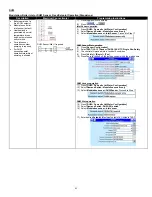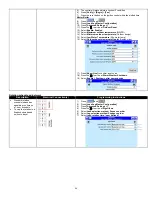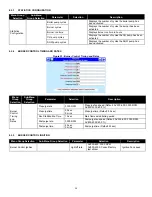
57
PART 8 FIELD STARTUP PROCEDURES
8.1
CHECKING THE INSTALLATION
Inspect the connections for water, gas and electricity.
Confirm that water is being pumped toward the heat exchanger inlet. Never pump away from the exchanger since this will result
in a low-pressure zone, which will allow localized boiling and result in heat exchanger damage.
Power to the boiler and pump must be from the same circuit to prevent the boiler firing in case the pump is inadvertently shut
off.
Vent all air from the heat exchanger prior to firing using the two air vents provided on the heat exchanger. Both air vents can be
accessed by removing the top cover and they are located on top of the
Advantus
heat exchanger.
Inlet gas pressure must be a minimum of 4.0
” W.C. for natural gas and 11” W.C. for propane.
With the boiler off, open the main gas supply valve and vent the trapped air from the piping leading to the boiler. Confirm that
all gas connections to the heater are tight and that there are no missing test plugs.
AV1000-4000
: Connect a manometer to obtain the differential air pressure between negative and positive ports, See Figure 11.
The air/gas ratio controller automatically adjusts to match the air signal on the gas side. In this way true mass flow control of
air/gas mix is achieved. All boilers are test fired and factory set. A test sticker with actual reading is affixed to the unit.
8.2
CHECKING THE CONSTRUCTION
Check the boiler wiring to see that it agrees with the wiring diagram supplied.
Confirm that all terminal strips and field connections are identified.
Confirm that the
Advantus
controller is set in the proper mode. Auto reset limits are fixed in all modes.
With the low end firing valve in the off position, switch on power to the boiler. The fan motor will accelerate until the Interrupted
Air Switch icon becomes green.
Once all lights past the STAT are green, the SOLA will try for ignition. When the igniter is hot enough, the gas valve actuator is
energized and if ignition is accomplished the Burner State will show “Run”. If ignition is not accomplished, the Burner State will
show “Safe Startup”. It is normal during initial startup, when air is being purged from the piping, to require two to three tries
before successful ignition.
With the boiler running, check for flue gas leaks around the flue outlet. Some minor leakage is acceptable.
Repair any major leaks prior to the next step.
At the factory adjustments were made to achieve proper input and acceptable burner performance at full input and at minimum
input.
8.3
GAS VALVE ADJUSTMENT PROCEDURE
Table 14: Combustion Values
Advantus Combustion Values
Natural Gas
Propane
CO
2
CO
CO
2
CO
Max Fire
9.0% - 9.5%
<100 PPM
10.5% - 11.5%
<100 PPM
Min Fire
8.0% - 8.5%
<100 PPM
10.0% - 10.5%
<100 PPM
If adjustment of the gas valve is required, use the following procedure.
It is imperative that the coldest system water temperature possible is used when setting up low fire combustion. These cold system
temperatures create large amounts of flue condensate resulting in large amounts of condensate build up on the stainless steel heat
transfer tubes. These conditions create the highest back pressure through the boiler and makes for the most critical combustion set up
point when running 10% input on models 500-600 and 4.0% input on models 800-4000. This set up must be achieved quickly to ensure
low system temperatures are maintained throughout the setup of single or multiple boiler installations.
Models 500
– 600
Light off the boiler and make the initial adjustment to the low fire bias to obtain the specified CO
2
, CO, at minimum gas input.
Allow the boiler to run for 5 minutes at 10% and then make the final low fire adjustment according to the combustion values above. Allow
the boiler to run up to high fire and set the combustion according to the combustion values above.
Summary of Contents for ADVANTUS AVH 500
Page 2: ......
Page 3: ......
Page 38: ...31 Figure 23 Recommended Piping with Reverse Return and Variable Primary Flow...
Page 88: ...81 PART 12 EXPLODED VIEW Figure A...
Page 89: ...82 Figure B FAN BURNER ASSEMBLY AV500 600 some items may not be as shown...
Page 90: ...83 Figure C FAN BURNER ASSEMBLY AV800 4000 some items may not be as shown...
Page 91: ...84 Figure D Figure E...
Page 92: ...85 Figure F Figure G...
Page 93: ...86 Figure H CONTROL BOARD ASSEMBLY...
Page 100: ...93 PART 13 ELECTRICAL DIAGRAMS...
Page 101: ...94...
Page 102: ...95...
















































